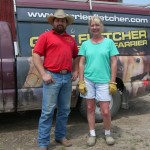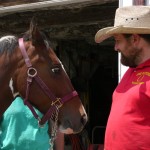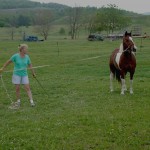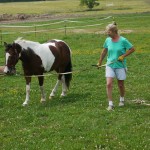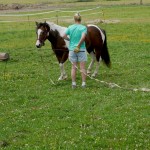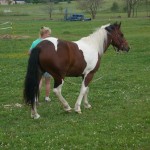On May 24th I climbed into my SUV and headed south on Route 220. I wasn’t quite sure where I was going; a farm on Route 6 just outside West Burlington, PA near Mount Pisgah State Park. When my children were young our family enjoyed the park, so I was familiar with the road. All I had to do was look for Gene’s distinctive truck. If it was parked anywhere near the road I couldn’t miss it. A few miles after Burlington, I began to worry, and then I rounded a bend in the road and spotted the truck. I pulled into the driveway where Deb Yoder and Gene Fletcher waited for me. I was there to watch a one hour training session with Deb and her horse Willow.
A little less than two years ago, Deb’s daughter, Charrissa, decided to purchase a horse. After looking on-line at pictures of horses for sale, she saw a pretty 4 month old filly. She called the owner and decided to buy the horse. One evening, Deb and Galen Yoder, with they’re trailer hitched to a truck met Charrissa and her husband, Ed, for a trip to Germanville, Pa, where they would pick up the filly. The owner brought out Willow and lunged her. Charissa began to understand that this young filly was high spirited and excitable. She decided Willow wasn’t the horse for her; however, Deb fell in love with the dynamic foal.
“What should we do? Put her in the trailer?” asked Galen.
“Yes, put the horse in the trailer. I’ll take her,” Deb said.
Willow began a new life on the Yoder cattle farm. Willow had her own pasture some distance from her stall in a large barn and the Angus herd. Gene Fletcher came down to trim her hooves every 8 weeks. Everyday Deb walked the filly back and forth between the barn and the pasture. One evening in June of 2011, Willow began to act up, rearing, pulling away, running around Deb, not listening and completely out of control. Finally, she managed to get the horse back in the barn. In a panic, she immediately knew who to call. Around 7 o’clock that evening, Gene pulled into the driveway in front of the barn, and Willow’s training began. Gene worked with Deb and Willow until dark.
“Willow was a wild horse, a firecracker and I felt Deb wouldn’t keep her,” said Gene.
“I always wanted a horse and love Willow. I didn’t want to give her up,” said Deb.
“Deb did all the work. I just told her what to do. I only worked with Willow in the beginning to understand what the horse was doing and why. Each horse is an individual. Before I can help the owner connect with their horse, I need to understand the horse,” said Gene.
“In the beginning, Gene came down about twice a week. There were a lot of problems to work out with the horse. Now, we have a training session twice a month or more often if I experience a problem with Willow,” said Deb.
“My method is to work with both the owner and the horse. An experienced trainer can quickly get a horse to do what he wants, but that doesn’t mean that an inexperienced owner will get the same results. I have the owner work with the horse under my instruction. That way the owner understands his/her horse and begins to build a bond with the animal. After each session, I give Deb homework to do with Willow. When I come back if they pass we go on to the next level of training, if not we work on correcting the problem,” said Gene.
“I work with Willow every day, take her out, bring her back and forth from pasture to barn, groom her, clean her feet,” said Deb.
“Willow is the cleanest horse in Bradford County,” said Gene.
“Do you work year round with Willow?” I asked.
“We don’t work in the winter, but as soon as the weather warms the work with the horse begins. This is the first training session since last fall. Right now, we are working with ground handling and lunging,” said Gene.
“How do you start?” I asked.
“I use a technique called Heeding developed by Ron Meredith from Meredith Manor Equine College where I learned to be a farrier. The method uses body language to control the horse and develop a friendship with the animal,” said Gene.
The Heeding technique is based on a simple premise; a trainer introduces a pressure to the horse then pays close attention to how the horse reacts to it. The method uses psychological techniques that the horse perceives as a shape.The best way to understand this is to watch how horses interact socially in a herd. Horse communication is based in large part on physical body language. If a horse trainer understands equine body language and uses it with the horse, he/she and the horse will come to understand each other. The trainer modifies pressure as the horse responses to his/her demands. How each horse reacts depends on the horse’s personality. Thus the more horses a trainer works with the greater his understanding of how to use Heeding.
Deb walked Willow from the barn to an open pasture a short distance away. Gene and I followed. We stood some distance from the horse and owner. Deb began to lunge Willow. She started lunging by walking in a tiny circle, taking small steps, extending the lunge line, moving her body to indicate what response she wanted from the horse. The whip was held by the hilt, whip end down dragging behind her as she walked. Willow responded by matching her steps with Deb’s. She released more rope when Willow behaved. If Willow drifted toward her or wanted to stop, Deb sent her back out into the circle. She never looked directly at the horse, but where she wanted the horse to go. The horse followed Deb’s footsteps. When Deb wanted the horse to trot, Deb took small trotting steps, and then when she asked for a canter, Deb made small cantering steps at the center of the circle. To stop Willow, Deb turned her body and shoulder toward the horse, brought the whip behind her back, extended her arm and then held the whip out in front and perpendicular to the animal.
“Eventually, the whip goes away, a halter isn’t needed. Just the person alone will be able to control the horse through natural body language the horse understands,” said Gene.
“That’s amazing,” I said.
“After Willow and Deb have mastered lunging, a surcingle will be used to simulate the girth. The horse will be lunged with the surcingle on. Gradually, other things will be added; a bridle and bit, reins, blanket, saddle and finally a rider. At each step the horse will continue to be lunged and given time to accept the new addition. Once Willow is ready to accept a rider, either Deb or I will first lean on the horse’s back to make sure Willow won’t buck. The idea is that the horse should never buck. When we are sure the horse is ready to accept a rider, one of us will get on. The person on the ground will lead the horse while the other person rides. Once Willow accepts a rider, she will be lunged with a rider. At the end of the entire process the horse should be able to be ridden without a bridle or halter,” said Gene.
“How long does it normally take?” I asked.
“The process can take as little as a month or as long as 3 years. It depends on the rider and their confidence level,” said Gene.
Deb asked Willow to reverse. She exchanging hands with the whip and the lunge line. Willow turned around and began walking in the other direction. At one point Willow lost attention, stopped and looked off across the pasture. When this happened Deb pulled on the lunge line, redirecting the horse’s head toward her. Once the horse regained focus, Deb asked the horse to walk around the circle. Another time Willow made a little, hoppy buck then continued cantering.
“Many times when the horse bucks people focus on the rear end and the kicking. The important thing is to not let the horse get into position to kick, which means stay focused on the where the head is. The horse’s head needs to be turned slightly into the circle when lunging,” said Gene.
The training session came to an end. We followed Deb and Willow out of the pasture. It wasn’t long before Deb put the horse back in her stall and joined us. Gene and Deb reviewed Willow’s progress with suggestions on how to improve the horse.
“Repetition is important in working with horses. Show the horse once then repeat it. The horse helps you along the way. The horse will show you what you have to do and will bring out of you what you need to do. They are great teachers,” said Gene.
“I know when I haven’t spent enough time with Willow. The training will go downhill,” said Deb.
“Another important thing to remember when working with horses is patience. Give the horse options, the horse eventually will make up its own mind to do what you are asking it to do. For example, if you’re walking the horse to a field and the horse rears and acts up, let the horse work through that, and then still go to the field. After awhile the horse will exhaust itself and realize that acting up is a useless endeavor. The horse realizes it takes too much energy to misbehave, in the end the horse is going to have to do what you asked of it. Just don’t give up, be patient. If you give up and let the horse get away with not doing what you ask, the horse will think its behavior is ok. There will be a turning point for the owner and the horse when they begin to understand each other and lines of communication will open,” said Gene.
“Gene makes it look easy but there are subtle body motions the horse picks up on. At first none of this seemed natural. Charissa made videotapes of me lunging and working with Willow when Gene wasn’t here. The videos are helpful. I can watch and play them over and over again. That way, I can see myself and the mistakes I am making,” said Deb.
“That’s a good idea. Did you ride horses when you were growing up? I asked.
“Not really, when I was 10 years old, my uncle had a black horse which I rode a few times. The horse was a little wild. My uncle didn’t have him long, maybe a summer, and then the horse was sold. I did some organized trail riding, but didn’t like it. The horses just walked behind each other. It wasn’t really riding,” said Deb.
“I’ve done that on vacation. You’re right it’s not like having your own horse,” I said.
“The horses are used to the routine in those places. Recently I heard a concession near Wellsboro closed their business and sold all their horses. A lot of people went up there to buy horses thinking that the horses were dead broke. They paid huge prices, in the thousands for each horse. Once the horses were brought home they acted up. The animals had simply learned a routine; they walked on the same trail with a lot of other horses over and over again. When the horse was taken out of that everyday ritual, they were very different. Horses look for patterns and repetition. They’re creatures of habit and notice when something is different,” said Gene.
“That’s true, I ride Pepper in the park over the same route. If anything is different, a new bench or a picnic table has been moved, even a new road marker, she is leery of it,” I said.
“It’s always good to remember that horses are prey animals and their fear is a survival instinct. You aren’t going to completely change that. You can desensitize the fear a bit, but it will always be there. It’s important to understand their fear and think about what type of things spook a horse,” said Gene.
“Anything else we should remember?” I asked.
“Always leave the training session on a good note. At Meredith Manor we were taught that a good note equals reinforcement, a bad note equals bad behavior,” said Gene.
“When do you think Willow and Deb will be ready to take the next step in training?” I asked.
“That all depends when Deb is ready,” said Gene.
“I have purchased the surcingle. I think sometime this summer,” said Deb.
The blazing sun shone down on us as we exchanged stories, chatted small talk and enjoyed each other’s company. Before long it was time to make the long drive home. I waved farewell to Gene and Deb, pulled away from the farm and headed down Route 6, past the filling station in Burlington and on towards the junction at Route 220.
Sources:
www.meredithmanor.com and www.meredithmanor.edu

